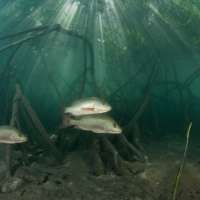Fish, corals and trees tell common story about climate change

Research by scientists from The University of Western Australia, the Australian Institute of Marine Science (AIMS) and partners from Australian and international institutions has shown that fish, corals and trees in north-west Australia respond to climate change with simultaneous growth patterns.
The results are published in the prestigious Global Change Biology.
The El Niño Southern Oscillation (ENSO) is a large-scale climate phenomenon that affects marine and terrestrial ecosystems globally.
The research found that during El Niño years, growth of the four study species (two types of marine fish, one coral and one tree) slowed, whereas in La Niña years with warmer sea temperatures and generally wetter years, growth rates increased.
The growth patterns of the four species were taken from annual bands found in fish ear stones (otoliths), coral cores, and tree stems, all of which contain information about how much these organisms grow every year.
Lead author of the study Joyce Ong, a PhD student from UWA's School of Animal Biology and Oceans Institute, said it is the first evidence of ENSO driving similar growth patterns in marine and terrestrial species in the southern hemisphere.
"These four different species span different trophic levels and environments, yet respond similarly to large-scale climate phenomenon," she said.
Co-author and UWA researcher Dr Pauline Grierson, a leading expert on tree chronologies, said the findings were particularly important for the eastern Indian Ocean and inland Australia, where gaps remained in both climatic data and ecological knowledge.
"Multi-species approaches, as demonstrated by our study, provide unprecedented levels of detail that increase confidence in climate models," Dr Grierson said.
Under predicted climate scenarios, rainfall and ocean temperatures are expected to increase in north-west Australia, which the study proposes would be good news for trees, fish and corals.
However Ms Ong said it was not that straightforward.
"The strong La Niña events with record high sea surface temperatures can have disastrous impacts as seen over the summer of 2011 where widespread fish kills and coral bleaching occurred," she said.
"These extreme La Niña events as well as strong El Niño conditions are predicted to occur more frequently in the future, indicating that events with extreme temperature changes that lead to damage or death and conditions favouring slower growth of marine and terrestrial organisms will be more common.
"The magnitude and frequency of El Niño and La Niña events are likely to have major negative consequences on both marine and terrestrial species and will need to be carefully monitored."
More information: Joyce J.L. Ong et al. Evidence for climate-driven synchrony of marine and terrestrial ecosystems in northwest Australia, Global Change Biology (2016). DOI: 10.1111/gcb.13239
Journal information: Global Change Biology
Provided by University of Western Australia





















